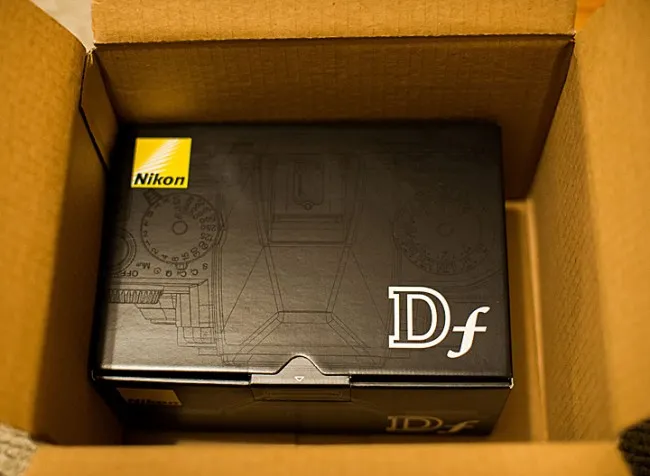
By Matt Cashore, University of Notre Dame
I suppose you could say I got serious about this whole photography thing around 1990, give or take. The first "serious" camera I bought for myself was a used Nikon FE-2. Black.
I got my first digital camera in 2002 and shot my last roll of film for a paid job around 2004. So you can arguably say half my photographic career has been in the film world and half in the digital world.
So when Nikon announced their new retro-styled Df body it certainly pushed the nostalgia button in my brain. However, it also fills an actual photographic need--a compact, lightweight, full-frame body which I can use as an inconspicuous walk-around camera or as a remote--particularly in sports situations. The D800 is just a little too slow for most sports purposes and 36MP files are just plain overkill for most of what I do. I tried the D600 a year or so ago but three consecutive backfocusing copies ruled out that option forever. The Df looked like it might check all the boxes that were important to me: Good low-light capability, decent FPS, compact and lightweight. The retro thing? Bonus. On a strictly personal note I have a hang-up about pop-up flashes on 'professional' DSLRS. They just don't belong. The fact that the Df was pop-up-less sealed the deal. I went with the all-black option because I intend to use this as a remote and black tends to hide better than silver.
My first impression out of the box was: "Hey, it's my FE-2!"
My next impression was: "This thing weighs next to nothing!"
So skipping directly to the pros and cons as I see 'em:
Pros:
1. Great sensor--hits the file size sweet spot (in my opinion)
2. No pop up flash (woo hoo!)
3. LCD is beautiful--the green cast that plagued the D4 and D800 screens seems to have been fixed
4. Smallest, lightest full-framed DSLR Nikon offers
5. WU-1A wireless transmitter--tiny and inexpensive
Cons:
1. Overpriced and by quite a bit, I think. Should be around $2000, not $2800.
2. Only one SD card slot and inconveniently located
3. Yet another type of battery with yet another type of charger
4. Ergonomics--today's cameras really *are* better!
5. WU-1A wireless transmitter--only works with Nikon's horrible app
Other random thoughts: I found myself reaching for the film advance lever several times during my first couple of outings with the camera. (How 'bout that muscle memory?) It feels a bit plasticky but I'll take that in exchange for the feather-light weight. Even when I have an AF lens on the camera I find myself manually focusing. (That whole muscle memory thing again.) I wish there was an option for an old-fashioned split-image focusing screen. Will I miss the option of switching to video mode? (The Df is stills-only) I honestly can't say. I'll find out.
I'm looking forward to putting the camera through it's paces. It's going to get its trial-by-fire (er...rather, ice) as my new hockey goal-cam. I've used it for two non-sports shoots so far and I've been impressed. Sample images from the camera are straight JPEG conversions from Photo Mechanic. No cropping, sharpening or toning by me. All settings are out-of-the-box.
My first chance to use the Df on a serious shoot was Notre Dame's trip to New York City for the Pinstripe Bowl. As opposed to the first 'straight-from-the-camera' JPEGs, it was a chance to really see what the .NEF files from this thing can do. In a word: Impressive. The day before I left for New York I got a press release that the Empire State Building would be lit blue and gold on the north and south sides, and red on the east and west sides in recognition of Rutgers and Notre Dame playing in the Pinstripe Bowl. I thought a dusk photo of the ESB with a deep blue sky and the Manhattan skyline behind it would be a cool image. Well...traffic delays meant I couldn't get to Manhattan until well after dark. My perch for the photo didn't allow a tripod or even a convenient ledge to do a long exposure, so handheld had to work. "Okay, Df, show me what you can do!" Processing the NEFs in Adobe Camera Raw (Creative Cloud version) was a breeze, and I was able to pull out clean detail in the shadows (at ISO 1600!) without blowing out the highlights from the streets. Post-dusk night photos aren't supposed to look this nice. Almost feels like cheating. Nah.
Game day was thankfully mild and clear, and as the late afternoon sun dipped behind Yankee Stadium it gave me another opportunity to test the dynamic range possible with the Df raw files. Once again I was impressed at how easy it was to preserve detail in highlights and shadows.
My only gripe about the Df was when I used it as a quick-grab body for some post-game player reaction. My fingers didn't find the buttons I needed quite quickly enough. As I said the ergonomics today are just better than they were 30 years ago.
P.S. - In my text I said I intended to use this as a Net Cam. It was, in a word: Brilliant. The whole setup fit better in the little box--there was more room for the Pocket Wizard, for instance, and the lighter weight meant it was much more likely not to get thrown out of alignment when the net was jostled & moved and whatnot.
Matt Cashore is the Senior University Photographer at Notre Dame and his Photoshelter page can be seen at photos.nd.edu/ and www.mattcashore.com.